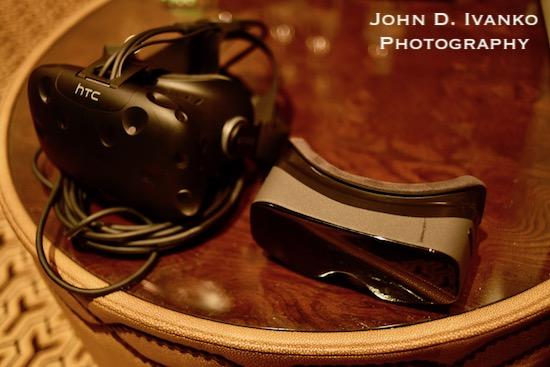|
Home
Articles
Reviews
Table of Contents
Search
Staff
| |
March 2018 - Seeing the Future of VR – Kopin Lightning OLED 2K Display
By Liam Kivirist of TechSocket.net
The CES (Consumer Electronics Show) in Las Vegas acts as a window to take a peek at the future of technology at the start of the year. While I had the chance to check out a wide array of new virtual reality, or VR, tech at CES 2018, display maker Kopin’s “Elf” VR headset stole the show when it comes to screen resolution and small form factor. That’s not entirely surprising as Kopin has been a leading manufacturer within the industrial and military VR and AR market. With a pair of their ‘Lightning’ OLED displays creating a 4,096 x 2,048 pixel image running at 120HZ, the Elf boasts more than triple the number of pixels on the standard Oculus Rift and HTC Vive. While VR might not yet feel like the future we’ve been promised in science fiction, Kopin’s Elf headset and Lightning displays feel like a step closer. |
 |
High Resolution and Light Weight, all in a Tiny Form Factor
The Elf VR headset utilizes a pair of Kopin’s OLED Lightning displays, with one for each eye, to accomplish such a high resolution. Each Lightning display is capable of running at 2,048 x 2,048 pixels at 120HZ. The two displays stitch together seamlessly to create a total resolution of 4,096 x 2,048. With the Lightning displays being OLED, you get a bright screen with incredibly dark and deep blacks. |
While creating a wide field of view (FOV) with such a small display is difficult, Kopin is researching and testing a large variety of optics systems to strike a balance of brightness, clarity and FOV. At CES, I had the opportunity to try a few of Kopin’s optics. Each optic solution had some minor visual trade offs with the FOV ranging from 70 to 100 degrees depending on the lenses.
“Virtual reality is a two part problem,” explains Eric F. Prechtl, Senior VR Systems Engineer at Kopin. “The first part is the display, the second part is the optics. With the [Lightning] displays you’ve got such a small display, but you want a really wide field of view. Ideally you want to get 100 to 120 degrees of field of view for proper immersion. The [Lightning] display is a small display, so Kopin is exploring different types of lens designs to get there. Here [at CES], we have two types of lenses: a Fresnel lens and what we call a ‘pancake type optics’. The non-Fresnel optics provide a smoother image but are much darker.”
At CES 2018, HTC also unveiled a new higher resolution VR headset, the HTC Vive Pro, an upgraded professional version of the regular HTC Vive. Even with a 78% resolution increase from the Vive, the HTC Vive Pro’s impressive 2,880 x 1,600 display still pales in comparison to the Elf’s pair of Lightning OLED displays that total 4,096 x 2,048 pixels. However, the comparison isn’t entirely fair as the Vive Pro is a complete VR system that will soon be for sale, whereas the Elf is simply a demonstration of the Lightning display’s potential.
The functional Elf VR headset prototype I had the chance to try on at CES 2018 is as impressively small in-person as in pictures. In its current form, Kopin’s Elf headset is able to provide higher resolution in a much small package than major competitors like the Vive or Rift. At around 300 grams, the prototype I experienced also comes in at just under half the weight of the standard Vive or Rift.
“The world is open for AR and VR, the valley has been reached and everyone is coming in,” shares John Fan, CEO of Kopin, during a VR/AR panel discussion facilitated by Kopin at CES 2018. The panel featured leading VR companies like Vuzix, RealWear and Lenovo that span across the consumer, industrial and enterprise markets. I was fortunate enough to be able to attend the panel and listen in on VR tech company executives discuss the current state and possible future for VR. The conversation was enthralling and one of the most insightful glimpses into the VR industry I experienced at the show. |

|
Sadly, The Elf Isn’t a Product
While the Elf headset edges us ever closer to sci-fi’s vision of cyberspace, it’s important to remember that the Elf isn’t a product. The Elf headset is a tool for Kopin to demonstrate the power of their Lightning 2K OLED displays, especially to electronic companies who may be interested in incorporating them into their own headsets or electronics. This means that while you may never own an Elf headset, components like the optics or Lightning displays could be in your next VR rig -- maybe without you even knowing.
Despite not being a commercial product, the Elf VR headset is an exciting indication of just how far the technology of virtual reality can still be pushed in terms of resolution and size. With such a realistic display and compact form factor, the Elf VR headset feels like it was pulled straight out of a science fiction film like Spielberg’s upcoming VR adventure, Ready Player One. Someday in the not-so-distant future, you could be viewing a hyper realistic cyberspace through a pair of Kopin’s Lightning OLED displays. |
Liam Kivirist
is a freelance writer for national magazines and editor for TechSocket.net. Follow his work at LiamKivirist.com.
email him at:
Photographs provided by John D. IVanko, you can see his work here
|
